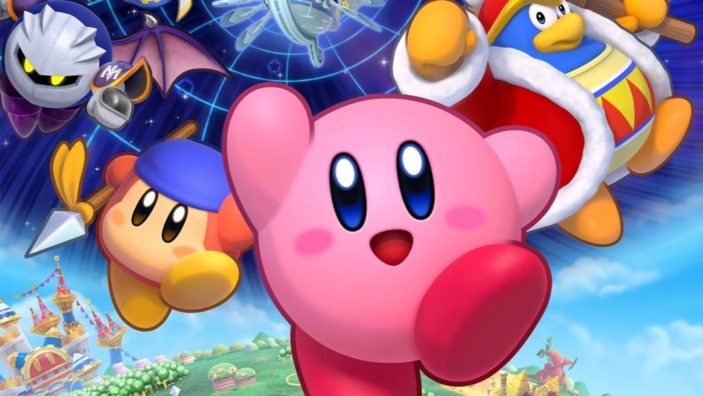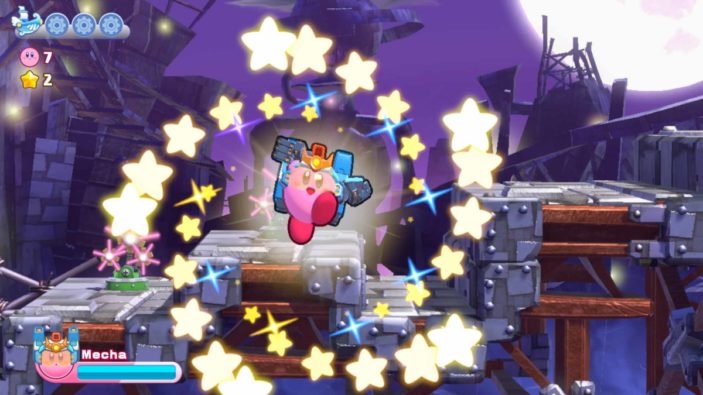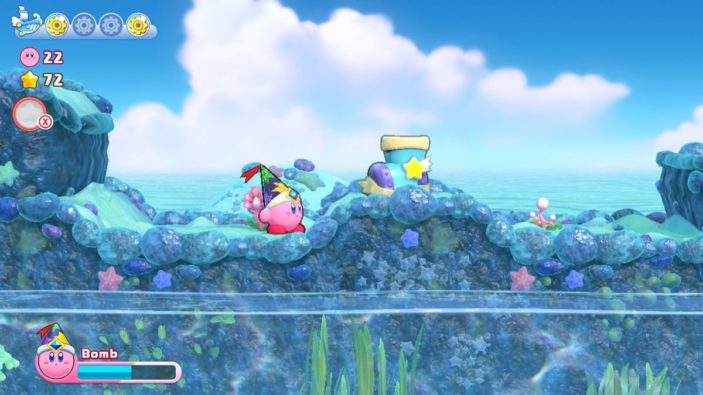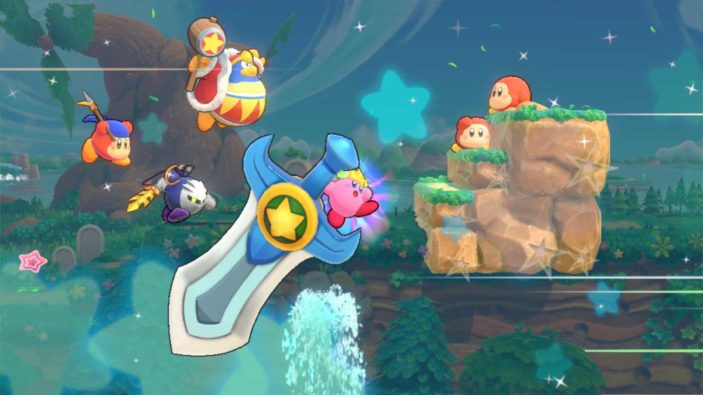
Originally releasing on the Nintendo Wii back in 2011, Kirby’s Return to Dreamland served as a safe and memorable entry in the franchise, featuring the titular and ever lovable pink icon. While Kirby’s Return to Dreamland Deluxe is certainly better than the original, it’s still very much the same game at its core, short of some new and interesting additions from gameplay adjustments and new modes. But through strong platforming mechanics, improved visuals and a short and sweet main adventure, gamers of all ages are sure to appreciate this for its consistent accessibility and charm.
Find the Pieces
If you’re used to Kirby platformers of old, you’ll find the main 6-7 hour story a breeze. Kirby has been tasked with rescuing an alien traveller known as the Magalor, as his ship crash lands on Kirby’s home of Planet Popstar. Kirby must now navigate various and unique environments to find the missing pieces of the Magalor’s ship. Simplistic story aside, Kirby’s adventures take place across eight worlds to jump, float and copy through, with various bosses to fight along the way. What follows is initially devoid of any real surprises and twists, while the latter half of the story feels like it takes more risks, while presenting players with more challenging and nuanced gameplay sections, relying more so on Kirby’s copy-based abilities.

It doesn’t make the first half a slog to play through as such, but does feel like it’s more so focused on presenting players with a smoother ride, rather than a hefty challenge. It’s worth keeping in mind however, that Kirby’s Return to Dreamland Deluxe isn’t frustratingly difficult at any point, and this former half simply acts as a more forgivable introduction to the controls and surrounding environments, which will most likely benefit both newer and younger players. This newer release also includes a mode called Helper Magalor, in which the alien supporting character provides players with useful items when they need them most. While veteran or returning players will likely never need to activate this mode, I can imagine they will appreciate the latter half for not only its gameplay, but its newer twists and turns, which are certainly worth sticking around for, thanks to an epic finale.
Same Kirby, Fresh Look
Gameplay mechanics feel almost exactly as they did in the 2011 original, even if this is anything but a criticism. General platforming feels tight and responsive, with Kirby’s various copying abilities adding variety to general platforming and encounters. Kirby’s Return to Dreamland Deluxe throws three new abilities Kirby’s way, with Sand, Mecha and Festival options to utilise. The Sand ability allows Kirby to manipulate sand to create objects to damage enemies with. The Mecha ability allows Kirby to wield a jetpack and fly about each environment to shoot lasers at enemies from hard to reach places. And finally, the Festival ability turns enemies into point stars and powerups that grant extra health. These abilities work well and generally feel like they belong, even if the Mecha ability feels like the most overpowered.

For as unique and fresh as these abilities look, it’s also worth noting here that the entire experience has received a fresh visual coat of paint, which looks absolutely gorgeous. Each of Kirby’s abilities and matching costumes look detailed and flashy, while each environment looks more vibrant and colourful than ever before. I wouldn’t expect Kirby’s Return to Dreamland Deluxe to push the limits of the Nintendo Switch hardware, but it runs incredibly well and consistently so.
Kirby’s Return to Dreamland Deluxe does however include a brand new mode, titled Magolor Epilogue: The Interdimensional Traveler. This mode presents players with an additional two-hour story that puts them in the shoes of the titular traveller, who begins their tale stripped of all their unique powers. Along the way, players will complete stages to collect magic points and unlock those lost and powerful abilities. By the end of the story, players will feel nearly invincible, as the Magalor shoots bombs and utilises a Monster Flame and Ultra Sword to ultimately destroy enemies. For as short as this mode is, it’s incredibly well paced and an equally charming addition to the main story mode. The only gripe I have here is that returning fans will have to slug through that initial six hour story to unlock this mode. An Arena Mode can also be unlocked after completing the story, which compiles the game’s main bosses into one giant gauntlet. This mode definitely provides the biggest challenge, but as previously mentioned, retuning players will fall into the same camp of having to play through that relatively easy story first.
Fun With Friends
Kirby’s Return to Dreamland Deluxe packs in a multiplayer mode, where up to four friends can paly as Kirby, Meta Knight, King Dedede, and Bandana Waddle Dee. This mode is functional, yet better suited to those with kids or younger groups of friends who simply want to join in or tag along, even if nothing really feels unique about this experience. Boss battles once provided the majority of challenge through the story, but can now be pummelled by your group, as timing no longer matters when everyone is spamming their own unique abilities away. Given the story’s shorter length however, cooperative fun rarely slows to a crawl and consistently throws new locations and enemies at players.

Merry Magoland is a new addition that serves as a carnival of sorts, housing various mini-games, most of which featured in the original 2011 game on the Magalor’s ship. With two new minigames along for the ride, players will use buttons or motion controls to compete in small games of skills. For example, players will throw ninja stars to hit the bullseye on a dartboard, or duel with samurai swords in a bid to see who can strike quicker. It’s all very Mario Party inspired, with each minigame only taking around 10-15 minutes to complete. But for as functional as they are, they don’t feel particularly deep. That being said, it’s a welcome addition for those who are after another party option for when friends are over.
Final Thoughts
Kirby’s Return to Dreamland Deluxe is a welcome remaster for both new and existing fans alike. While the first half of the main story might feel a little tame for some, newcomers and younger audiences will find a charming and well paced narrative at its core. Veterans will certainly prefer both the latter half of the story and Arena Mode for the sake of a tougher challenge, while the experience spreads its wings and caters for a busier atmosphere with cooperative play and the new Merry Magoland mode. While these minigames are relatively shallow, this refreshed experience has successfully melded an already great game with enough reasons to return and fall in love all over again.
FOUR STARS (OUT OF FIVE)
Highlights: Short and sweet story; Additional abilities for Kirby and standalone Magalor story; Vibrant visuals
Lowlights: New and additional modes require finishing the main story, which might annoy returning fans; Merry Magoland minigames aren’t particularly deep
Developer: HAL Laboratory, Vanpool
Publisher: Nintendo
Platforms: Nintendo Switch
Available: Now
Review conducted on Nintendo Switch with a pre-release code provided by the publisher.
